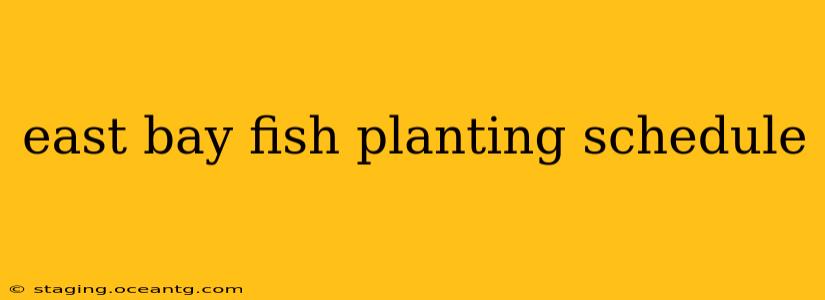The East Bay, with its diverse waterways, offers fantastic fishing opportunities. Knowing the fish planting schedule is key to maximizing your chances of a successful fishing trip. Unfortunately, there isn't one single, centralized schedule for all East Bay fish planting. The schedule varies considerably depending on the specific body of water and the managing agency (often the California Department of Fish and Wildlife (CDFW) or local agencies). This guide will help you navigate the complexities of finding the information you need.
Where to Find East Bay Fish Planting Schedules
Finding the precise planting schedule requires a bit of detective work, as it's not always consolidated in one easy-to-find location. Here’s how to locate the information:
-
California Department of Fish and Wildlife (CDFW) Website: This is your primary resource. The CDFW website often publishes stocking reports, though these are sometimes delayed and may not cover all East Bay locations. Search the website specifically for the lake or reservoir you’re interested in. Look for terms like "stocking report," "fish planting schedule," or the specific lake name.
-
Local Parks and Recreation Departments: Many East Bay parks and recreation departments manage their own lakes and ponds. Check their websites or contact them directly for their planting schedules. This is particularly important for smaller, less-known fishing spots.
-
Fishing Clubs and Local Anglers: Join local fishing clubs or engage with online fishing forums specific to the East Bay. Experienced anglers often share information about recent plantings and fishing conditions.
-
Bait and Tackle Shops: Local bait and tackle shops are invaluable resources. They're often in the know about recent plantings and current fishing reports.
What Types of Fish are Commonly Stocked in the East Bay?
The East Bay's lakes and reservoirs are typically stocked with various species, including:
- Trout: Rainbow trout are a common stocking choice, often providing excellent fishing opportunities.
- Catfish: Channel catfish are popular and provide a good fight for anglers.
- Bass: Largemouth bass and smallmouth bass are found in some East Bay waters, although stocking may vary.
The specific species stocked will depend on the body of water and its suitability for different fish.
How Often are Fish Planted in the East Bay?
The frequency of fish planting varies greatly. Some locations may receive regular plantings throughout the year, while others may only be stocked seasonally, typically during the cooler months (fall, winter, and spring) when trout thrive.
What are the Best Times to Fish After a Planting?
The best time to fish after a planting is generally within a week or two. Fish are often more concentrated and easier to catch immediately following a stocking. However, this can vary based on weather and other factors.
Are there any restrictions or regulations I should be aware of?
Always check the CDFW website for current fishing regulations before you head out. These regulations can include:
- License requirements: You will need a valid California fishing license.
- Bag limits: There are limits on the number of fish you can catch per day.
- Size limits: Some species may have minimum or maximum size restrictions.
- Gear restrictions: Certain types of fishing gear may be prohibited.
Failure to comply with regulations can result in fines.
Can I find the fish planting schedule for [Specific Lake Name]?
Unfortunately, I cannot provide a specific fish planting schedule for individual lakes without knowing the lake's name and managing agency. Use the resources mentioned above to find the information for the specific lake you're interested in. Remember to check regularly, as schedules can change.
This comprehensive guide helps you navigate the process of finding the East Bay fish planting schedule. Remember that consistent effort in your research is key to successful fishing trips. Tight lines!
